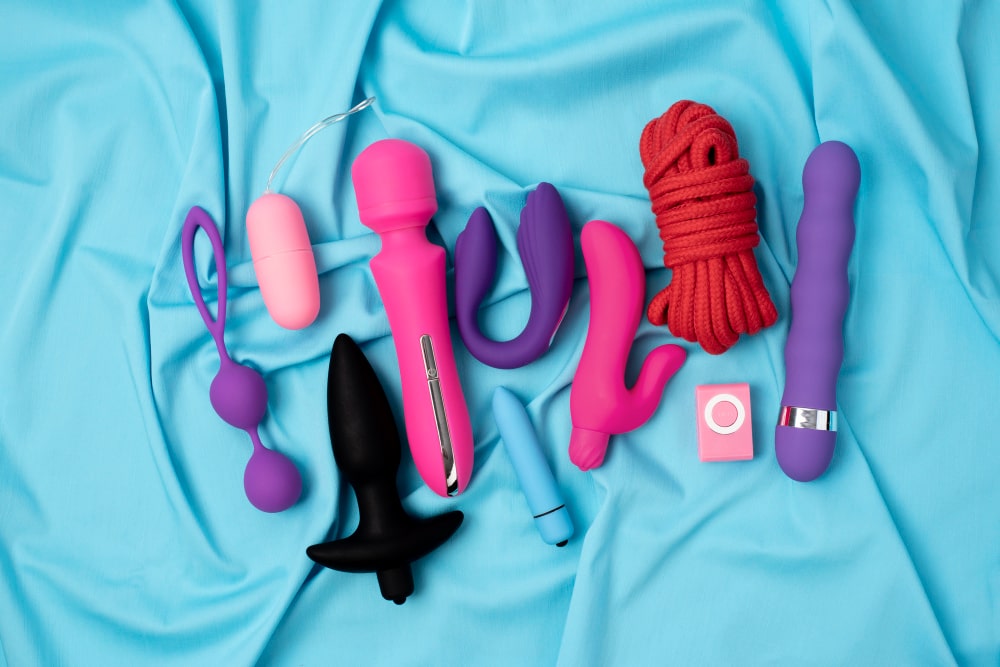How are dildos made? It’s a mix of curiosity and wanting to ensure what we use is safe and of good quality. It’s essential to know what we’re introducing to our bodies, and I’ve been down that path of uncertainty, too.
This article will satisfy your curiosity and gain a comprehensive understanding of the materials and processes involved. Knowledge is power; in this case, it can lead to safer and more informed choices.
For those of you in a rush: Dildos are crafted from various materials like silicone, rubber, and glass, and their manufacturing process ensures they’re body-safe and durable. But there’s so much more to it, and I promise it’s fascinating! So, let’s discover them all together.

What Are Dildos?
Dildos are sex toys designed for penetration. They can be used vaginally, anally, or even orally. Unlike vibrators, they don’t typically have any electronic components or moving parts. Think of them as tools for pleasure, crafted to mimic the shape and feel of a human penis, though some can have abstract designs.
The primary use of a dildo is for sexual stimulation. Whether you’re using it solo or with a partner, its main job is to pleasure penetration. It’s a way to explore one’s body, understand what feels good, and sometimes, simulate the experience of intercourse.
Dildos have been around for thousands of years. Ancient civilizations made them from stone, wood, and even gold. Over time, as technology and materials advanced, so did the design and functionality of dildos.
In the 20th century, the introduction of rubber and then silicone revolutionized the dildo industry. These materials felt more lifelike and were safer for internal use. Today, we have dildos that can change shape, heat up, or even be controlled remotely.
Most Realistic Dildo!
What Are Dildos Made Of?
Many people wonder what are dildos made from. And there is no one short and right answer. They can be crafted out of many materials. And, when it comes to dildos, the material is everything. It determines how the toy feels, how it’s cleaned, and how long it lasts. Let’s dive into the most common materials and their characteristics.
Silicone
Silicone is probably one of the most popular materials on how dildos are made. Sourced from silica, which is derived from sand. It’s then transformed into silicone through various chemical processes.
Fun fact: Silicone is also used in medical implants, showing how body-safe it is!
- Pros: Body-safe, non-porous (doesn’t harbor bacteria), feels lifelike, and has various firmness levels.
- Cons: It can be pricier and should be used with something other than silicone-based lubes as it can degrade the material.
Rubber/Latex
Comes from the sap of rubber trees. The sap is collected, processed, and then turned into the flexible material we know.
- Pros: More affordable, flexible.
- Cons: Porous (can harbor bacteria), might cause allergic reactions in some people, not as durable as silicone.
Glass
They are made from silica sand, soda ash, and limestone. These are melted together at high temperatures to form glass. Some dildos use borosilicate glass (think Pyrex) for added strength and resistance to temperature changes.
- Pros: Non-porous, very smooth, can be heated or cooled for temperature play.
- Cons: It can be fragile, not flexible, and intimidating for beginners.
Metal (like stainless steel)
They are typically made from stainless steel, a mix of iron, carbon, and chromium. This combination ensures durability and rust resistance.
- Pros: Non-porous, durable, and can be used for temperature play.
- Cons: Heavy, not flexible, can be on the pricier side.

Historical Context
Dildos have a rich history that spans thousands of years. Their journey from ancient artifacts to modern-day pleasure tools is fascinating.
Who Made Dildos?
- Ancient China: Used dildos made of bronze and other metals, often intricately designed.
- Ancient Greece: Dildos, or “olisbos” as they were called, were made from leather, wood, and even bread. They were sometimes used by women whose husbands were away.
- Ancient Egypt: Phalluses made of stone or leather were used in rituals and for pleasure.
- 20th Century: With the sexual revolution, the demand for sex toys, including dildos, surged. This led to the establishment of many businesses focusing on their production.
- Modern Era: The rise of the internet and e-commerce platforms has allowed niche markets, custom designs, and a broader reach for manufacturers. Brands now prioritize body-safe materials and inclusive designs.
Why Are Dildos So Big?
- Representation of Power: In some cultures, a larger phallus was seen as a symbol of power and fertility.
- Variety: Just as people have varied tastes in food or music, there’s a range in what they seek for pleasure. Bigger dildos offer a different sensation and experience.
- Fantasy Fulfillment: Some users might not necessarily want a life-sized replica but are looking to fulfill a particular fantasy.
Evolution of Size Preferences
- Ancient Times: Most ancient dildos were relatively modest in size, often mimicking the average size of a human penis.
- Modern Era: With the expansion of the market and the destigmatization of sexual exploration, there’s been a rise in both smaller and larger designs, catering to all preferences.
Common Pain Points to Be Aware Of
- Overestimation: Especially for beginners, it’s easy to overestimate what size is comfortable. Always start smaller and work your way up.
- Safety: Larger dildos require more preparation and relaxation. Listening to your body and ensuring you’re not causing harm is essential.
- Storage: Bigger toys require more discreet or spacious storage solutions.
Conclusion
Understanding how are dildos made is more than satisfying curiosity; it’s about ensuring safety and quality and making informed choices. From their ancient origins to modern manufacturing, dildos have evolved in design, material, and purpose.
Whether it’s silicone, rubber, glass, or metal, each material offers a unique experience, and the vast size range caters to varied preferences. As we’ve journeyed through their history and construction, it’s evident that dildos are not just tools for pleasure but also symbols of cultural evolution and personal exploration.
Always prioritize safety, and here’s to making informed and delightful choices in your pleasure journey!




